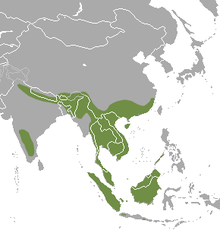Dwarf otters
| Dwarf otters | ||||||||||||
|---|---|---|---|---|---|---|---|---|---|---|---|---|

Little otter ( Aonyx cinerea ) |
||||||||||||
| Systematics | ||||||||||||
|
||||||||||||
| Scientific name | ||||||||||||
| Aonyx cinerea | ||||||||||||
| ( Illiger , 1815) |
The pygmy otter ( Aonyx cinerea ), sometimes also referred to as the short-clawed otter , is a species of predator from the subfamily of the otters (Lutrinae) widespread in Southeast Asia . It was previously placed in the independent genus Amblonyx .
features
With a head body length of 45 to 61 centimeters, a tail length of 25 to 35 centimeters and a weight of 1 to 5 kilograms, it is the smallest otter. Its fur is dark brown or gray on the surface, the face, neck and belly are lighter. Like the finger otters, it has greatly reduced claws that are of little use. The webbed feet are also regressed, which enables great mobility of the individual fingers.
distribution and habitat
The distribution area of the pygmy otters extends from India and the southern People's Republic of China across the Malay Peninsula to Borneo and Java and also includes the southern Philippines . They inhabit areas with dense vegetation near bodies of water, both by rivers and at estuaries and along coastlines.
Way of life
Little otters are more sociable than the other otter species, they live in family groups of up to twelve animals. They play with each other and communicate using a series of sounds.
Their very strong teeth are used to crack soft and crustacean shells , in which they have largely specialized as food. Fish play a subordinate role on the menu of the dwarf otters. In contrast to many other species of otters, they pick up food with their paws and not with their mouth, often digging through the sand or mud with their paws in search of something to eat.
Reproduction
After a gestation period of around 60 to 64 days, the female gives birth to one or two young. At birth, both parents create a small burrow in the mud in which the newborns spend their first weeks of life. After 80 days you can eat solid foods. In contrast to the other species of otters, pygmy otters can give birth twice a year.
Hazard and protection
Zwergotter apply to the endangered species Red List of the World Conservation Union IUCN as threatened ( Vulnerable ). Their fur is classified as less valuable than that of the otter , so that it was hunted far less than the hair-nosed otter , which is common in the same area . Nevertheless, there is a decline in the population due to the destruction of their habitat.
Like all species of the subfamily otters (Lutrinae) , the pygmy otter is protected by trade restrictions through the Washington Convention on CITES, Appendix II . For this purpose, the European Union also sets the species on Appendix B of the EU Species Protection Regulation (EC) No. 338/97 or the amendment by EC Regulation 407/2009. The Federal Republic of Germany provides to the designation of all species of the genus Aonyx as special protection in the Federal Nature Conservation Act , the legal basis for protective measures, this marten.
swell
Individual evidence
- ^ The CITES Appendices. CITES Convention on International Trade in Endangered Species of Wild Fauna and Flora, accessed on January 18, 2010 (English, The Appendixes of the Washington Convention on the Protection of Species, CITES).
- ↑ Regulation (EC) No. 338/97 of the Council of December 9, 1996 on the protection of specimens of wild fauna and flora by monitoring trade
- ↑ Regulation (EC) No. 407/2009 amending Regulation (EC) No. 338/97 of the Council on the protection of specimens of wild fauna and flora by monitoring trade , accessed on January 19, 2010
- ↑ WISIA search service of endangered species. In: WISIA Online. German Federal Agency for Nature Conservation, accessed on January 19, 2010 .
literature
- Ronald M. Nowak: Walker's Mammals of the World . Johns Hopkins University Press, 1999 ISBN 0-8018-5789-9
Web links
- 55 photos including battle of animals + close-ups
- Aonyx cinereus in the endangered Red List species the IUCN 2009. Posted by Hussain, SA & de Silva, PK, 2008. Accessed January 19 of 2010.

